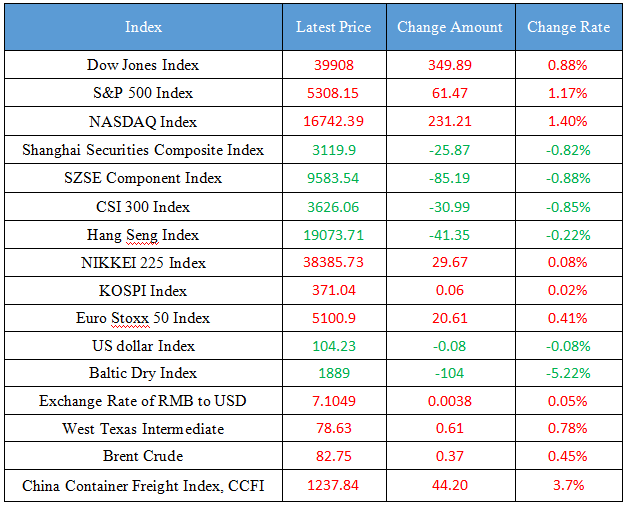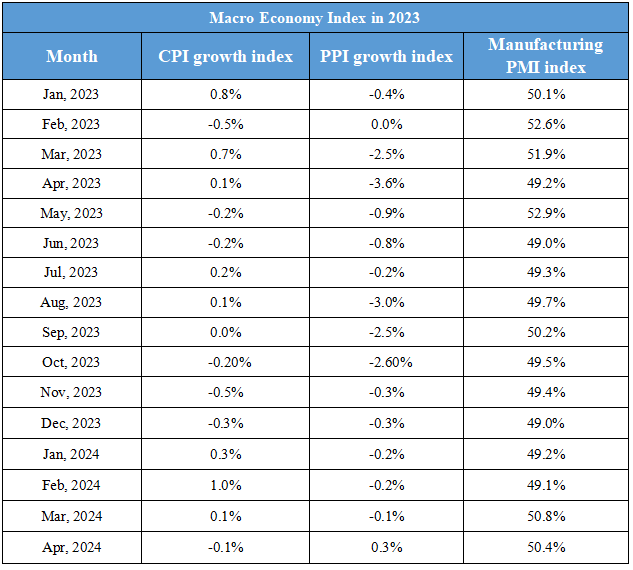May 16th Macroeconomic Index: China's Autumn Grain Purchases Reach New High, Green Supply Continues to Increase
Latest Global Major Index

International Crude Price Trend and Exchange Rate of RMB to USD Trend

Domestic News
1. State Food and Material Reserves Administration: The purchase of the 2023 autumn grain at peak season has ended, with total amount of purchases reaching a new high in recent years
2. Oil prices are going to drop, and filling up a tank of oil will save 9 yuan
3. China Securities Regulatory Commission: Strengthen the supervision of high-frequency trading and clarify the definition of high-frequency trading
4. China's green supply continues to increase, and since 2012, the energy consumption of industrial units’ added value above designated scle has decreased by more than 36%
5. Xinhua Times Commentary: Firmly follow the Chinese high-quality development road
International News
1. The Baltic Dry Bulk Freight Index fell for the fifth consecutive trading day
2. Reuters survey: U.S. EIA crude oil inventories are expected to decrease last week, and refined oil inventories may increase
3. CPI boosts the expectation of interest rate cuts, and U.S. stocks open higher
4. "Fed Mouthpiece": The Fed may still not cut interest rates until September
5. Canada's manufacturing sales fell in March
Domestic News
1. State Food and Material Reserves Administration: The purchase of the 2023 autumn grain at peak season has ended, with total amount of purchases reaching a new high in recent years
Qin Yuyun, deputy director of the State Food and Material Reserves Administration, said at the press conference that at present, the purchase of the 2023 autumn grain peak season has ended, and the total amount of purchases has reached a new high in recent years. Qin Yuyun said that as of April 30, all kinds of grain enterprises in the main producing areas had purchased more than 200 million tons of autumn grain, a new high since the reform of the corn storage system in 2016. Among them, the purchase of corn reached 135 million tons, an increase of 5.2 million tons year-on-year. (Chinanews.com).
2. Oil prices are going to drop, and filling up a tank of oil will save 9 yuan
According to the monitoring of the Price Monitoring Center of the National Development and Reform Commission, international oil prices fell during the current round of refined oil price adjustment cycle (April 29 to May 14). On average, London Brent and New York WTI oil prices fell by 4.8% compared with the previous price adjustment cycle. The reporter learned from the National Development and Reform Commission today (15th) that from 24 o'clock on May 15, domestic gasoline and diesel were reduced by 235 yuan and 225 yuan per ton respectively. The national average is 0.18 yuan per liter for No. 92 gasoline, 0.19 yuan per liter for No. 95 gasoline, and 0.19 yuan per liter for No. 0 diesel. According to the estimation of the 50L capacity of the fuel tank of the average family car, it will cost 9 yuan less to fill up a tank of 92 gasoline. (CCTV Finance)
3. The China Securities Regulatory Commission: Strengthen the supervision of high-frequency trading and clarify the definition of high-frequency trading
The China Securities Regulatory Commission (CSRC) issued the Regulations on the Administration of Programmatic Trading in the Securities Market (for Trial Implementation), which mentions clarifying the requirements for transaction monitoring and risk prevention and control. The stock exchange implements real-time monitoring of programmatic trading and focuses on abnormal trading behavior. At the same time, the customer management responsibilities of securities companies will be further consolidated, and the compliance and risk control requirements for institutional investors will be clarified. Fourth, strengthen the management of information systems, and clarify the regulatory requirements for technical systems, trading units, hosting, and access to trading information systems related to programmatic transactions. Strengthen the supervision of high-frequency trading. Clarify the definition of high-frequency trading, and put forward differentiated regulatory requirements in terms of reporting information, fees, transaction monitoring, etc.
4. China's green supply continues to increase, and since 2012, the energy consumption of industrial units’added value above designated scle has decreased by more than 36%
Green and low-carbon development is the direction of scientific and technological revolution and industrial transformation in the world today. The reporter learned from the Ministry of Industry and Information Technology that since 2012, the energy consumption of China's industrial units above designated size has decreased by more than 36%. More and more regions, industries, and industries are doing "addition and subtraction" to polish the main color of "green development". (Gongxin Weibao)
5. Xinhua Times Commentary: Firmly follow the Chinese high-quality development road
Xinhua News Agency said in an article that China's promotion of high-quality development is a realistic choice to adapt to the new stage of development and an inevitable requirement for maintaining sustained and healthy economic development. At present, the United States and the West are hyping up the so-called "China's overcapacity problem", pointing the finger at China's new energy industry, which has a global comparative advantage, and its essence is to distort and smear China's high-quality development path and block China's leap path in the global industrial chain value chain. If we understand the inevitable logic of China's high-quality development, we will understand that China will definitely not be "fooled" by this rhetoric. China has shown and will continue to prove with concrete actions that China has always unswervingly followed its own path, done its own thing without distractions, firmly promoted high-quality development, promoted high-level opening-up, and promoted China's steady and long-term economic development, and will surely make greater contributions to the world.
International News
1. The Baltic Dry Bulk Freight Index fell for the fifth consecutive trading day
The Baltic Dry Bulk Index fell for the fifth straight session on Wednesday as freight rates for all types of vessels fell. The Baltic Dry Index fell 104 points, or 5.22%, to 1,889 points, the biggest one-day drop since April 23. The capesize freight index slipped 232 points, or 7.92%, to 2,699, the lowest level in nearly two weeks. The average daily profit of capesize vessels fell by $1,928 to $22,383. The Panamax freight index fell 73 points, or 3.69%, to 1,905 points. The average daily profit of Panamax ships fell by $658 to $17,141. The Supramax bulk carrier freight index fell 22 points or 1.49% to 1,453 points.
2. Reuters survey: U.S. EIA crude oil inventories are expected to decrease last week, and refined oil inventories may increase
Ahead of the release of the EIA crude oil inventories data, a Reuters poll showed that U.S. crude inventories were expected to decline last week, while refined product inventories were likely to rise. Eight analysts estimated that crude inventories would fall by an average of about 500,000 barrels in the week ended May 10. Analysts also estimate that gasoline inventories will rise by about 500,000 barrels last week, and distillate inventories, including diesel and heating oil, are expected to increase by about 800,000 barrels; Refinery equipment utilization is expected to increase by 0.7 percentage points to 89.2% from 88.5% in the previous week.
3. CPI boosts the expectation of interest rate cuts, and U.S. stocks open higher
The three major U.S. stock indexes opened higher, with the Dow up 156 points, the S&P 500 up 0.4%, and the Nasdaq up 0.5%. WSB concept stocks rallied and cooled, and Game Station (GME. N) fell 15.9%, and AMC Cinemas (AMC. N) fell 10.5%. Baidu (BIDU. O) rose 1.3% after the company said it was considering possible partnership opportunities with Tesla on Robotaxi, and Tesla (TSLA. O) rose 0.8%.
4. "Fed Mouthpiece": The Fed may still not cut interest rates until September
Nick Timiraos, the "Fed's mouthpiece", wrote that the April inflation report showed that price pressures eased last month, which should make it easier for Fed officials to keep policy unchanged at next month's meeting. The report alone was not enough to convince officials that the three higher-than-expected inflation data at the start of the year were a deviation from the downward trend in price pressures expected by policymakers. With two more reports likely to be needed to shore up officials' confidence that inflation can return to the lower levels prevailing before the pandemic, the Fed may not be prepared to cut rates before September.
5. Canada's manufacturing sales fell in March
Canada's manufacturing sales fell again in March, as both oil and auto shipments fell sharply, leading to the biggest drop in manufacturing sales in five months. Statistics Canada reported on Wednesday that seasonally adjusted manufacturing sales were $69.88 billion, down 2.1% from the previous month, equivalent to $51.19 billion. This points to a decline in the volume of goods, further indicating a softening economic backdrop at the end of the first quarter. In the first three months of the year, Canadian manufacturing sales fell by 0.9%, mainly due to a decline in sales of transportation equipment and primary metals. Canada's sector-level GDP grew in the first two months of the year, but initial signs showed that growth flattened in March as declines in manufacturing and retail offset growth in the utilities, real estate, leasing and leasing sectors.
Domestic Macro Economy Index














